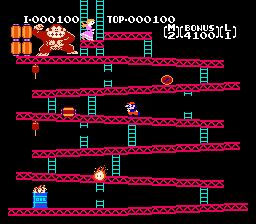All about Mario in general
Mario is now about 30 years "old" but he's still one of the "youngest" game-heroes, however certainly also one of the most successful. Super Mario is famous all over the world for "his" genre, the jump'n'run-games/platformers and newly also for his racing- (Mario Kart created the genre of fun-racers) and sport-games. Here is a brief description of his history and his most famous games.
The beginnings
Mario was invented in 1981 by the Japanese Shigeru Miyamoto. On the NES he made his first apparition in the game "Donkey Kong" when DK kidnapped his girlfriend Pauline. Mario (at that time he was called Jumpman and was a carpenter) had to climb and jump over Donkey Kong's barrels to rescue her.
At this time, technologies weren't as good as nowadays so Mario (called so afterwards because of his Italian look) got a mustache instead of a mouth and a cap instead of hair because they were easier to see in the low resolution. He was also given an overall to see his arms better when he was moving.
By the way, it's no accident that Mario isn't a handsome prince but a simple plumber : Shigeru Miyamoto wanted to make his character a hard-working person so that the players could identify with him. He also wanted him to be an ordinary man, neither heroic nor handsome.
His brother Luigi first appeared in "Mario Bros." (NES, 1983), many of the now known enemies (such as Goomba, Koopa and Bowser) made their debut in "Super Mario Bros." (NES, 1985). This game was Mario's big breakthrough, with the new scrolling-technique it revolutionized the videogame-market and became the base for the following platformers. It's still one of the most successful videogames with 40 million copies sold. The reason, why Mario is often called "Super Mario" also results from this game : when he eats a super-mushroom he grows to the double size and becomes Super Mario.


Famous games
"Donkey Kong" is still one of the best-known arcade-games but Mario's triumphal procession only began a few years later with the Super Mario Bros.-series for the NES. The first part was a big commercial success with 40 million copies sold and also "Super Mario Bros. 3" was very popular and it is often considered as one of the best two-dimensional platform-games. "Super Mario Bros. 2" is not as popular as the other parts of the series. This game is a rather bizarre Mario-adaption of "Doki Doki Panic" which replaced the Japanese "Super Mario Bros. 2" (later called "Super Mario Bros. : The Lost Levels" outside Japan), judged too difficult by Nintendo.
The Super Nintendo also had some interesting games. First of all, there's "Super Mario World" which is often considered as the best Mario-game ever. This two-dimensional platformer includes more than 90 levels and offers much fun. It's also the beginning of Yoshi's career and as the green dinosaur became so popular, he was made the main character of the next part. In "Super Mario World 2 : Yoshi's Island" the friendly dinos help Baby Mario, this game also offers a view at the beginning of Mario's and Luigi's lives.
With the Nintendo 64, it became necessary to focus on three-dimensional videogames. "Super Mario 64" marked the beginning of Mario's 3D-career and proved that the plumber's games could survive the end of the two-dimensional era. The Paper Mario-series also started on the N64, these RPGs play in an unusual paper-like world.
"Super Mario Sunshine" and "Luigi's Mansion" were the only interesting Mario-games for the Gamecube but these parts are rather disappointing in my opinion. The Wii-games "Super Mario Galaxy" and its sequel which play in space offer a much more innovative gameplay that is often praised.
Mario also had some interesting appearances on the portable consoles. First of all, there's "Super Mario Land" (released in 1989), the first platform-game with Mario on the Game Boy. It became very famous even though it's technically poor (contrary to "Super Mario Land 2 : 6 Golden Coins" which was able to keep up with the games of the big consoles).
Since "Yoshi's Story" (N64, 1997) there was a long time without new classical platform-games being published (there were only some remakes released for the Game Boy Advance) but with the Nintendo DS the two-dimensional platformers which established Mario's success had their comeback. "New Super Mario Bros." (2006) succeeds in mixing three-dimensional elements with the 2D-atmosphere. "Super Princess Peach", "Yoshi's Island DS" and the next parts of the Mario & Luigi-RPGs (a series which started on the Game Boy Advance) are other famous games for the Nintendo DS.
Nintendo also used Mario's good name to create new game-genres with the plumber, such as Mario Kart or Mario Party which were (and are) a big success.




